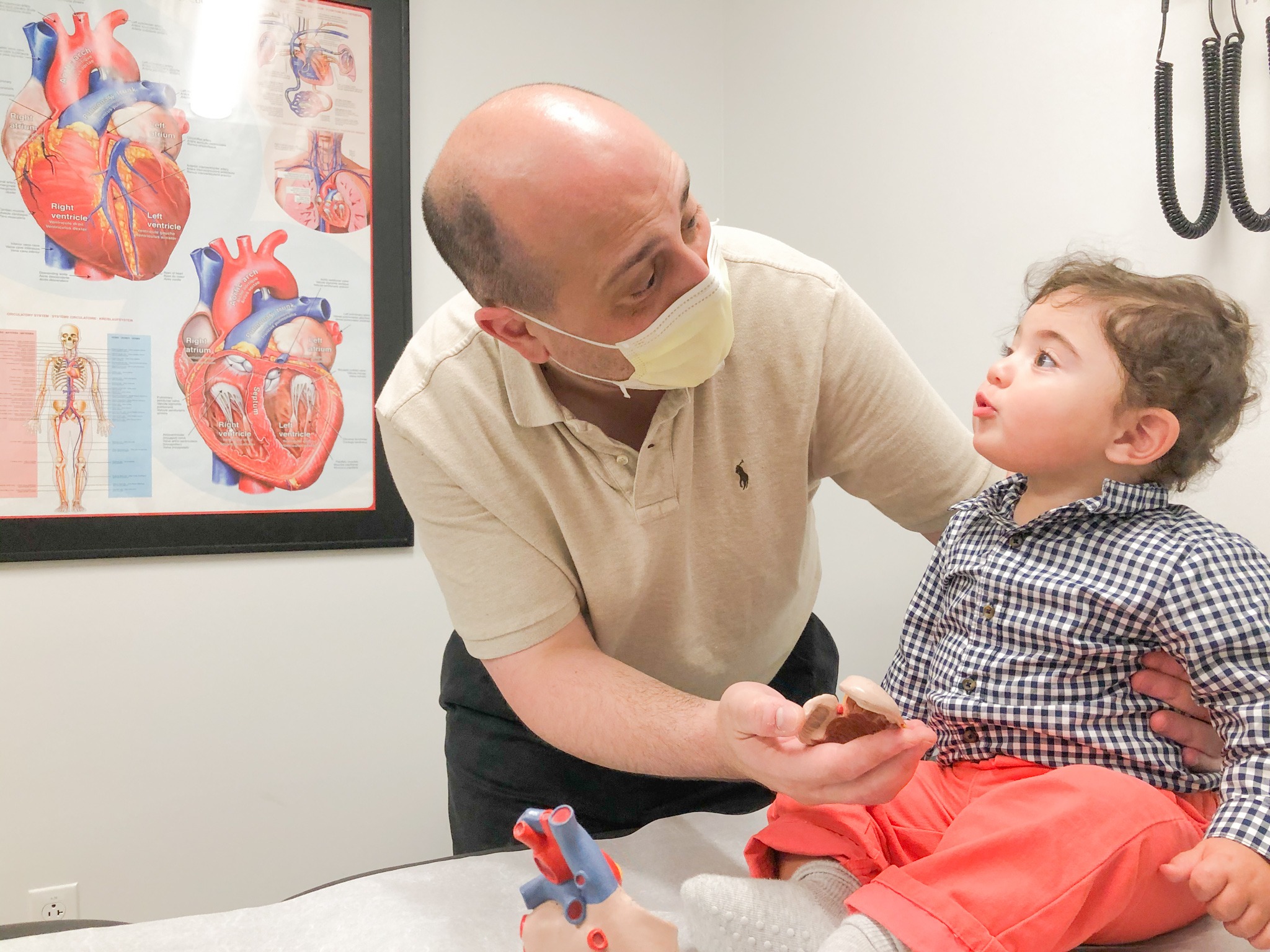Pediatric Cardiology

Pediatric Cardiology
We are proud to serve Bay and surrounding counties as the only pediatric cardiology clinic in the area.
Dr. Ebeid senior has been serving the area in pediatrics and general pediatric cardiology for the past 35 years
Our Pediatric Cardiology Services
We provide full in-house non-invasive pediatric cardiology services, including:
Electrocardiogram (ECG / EKG)
Electrocardiograms — also called ECGs or EKGs — are often done in a doctor’s office, a clinic or a hospital room, and they’ve become standard equipment in operating rooms and ambulances.
An ECG is a noninvasive, painless test with quick results. During an ECG, sensors (electrodes) that can detect the electrical activity of your heart are attached to your chest and sometimes your limbs. These sensors are usually left on for just a few minutes.
The doctor will discuss your results with you the same day as your electrocardiogram.
Echocardiograms (echo)
Quick facts
- An echo uses sound waves to create pictures of your heart’s chambers, valves, walls and the blood vessels (aorta, arteries, veins) attached to your heart.
- A probe called a transducer is passed over your chest. The probe produces sound waves that bounce off your heart and “echo” back to the probe. These waves are changed into pictures viewed on a video monitor.
- An echo can’t harm you.
Why do people need an echo test?
Your doctor may use an echo test to look at your heart’s structure and check how well your heart functions. The test helps your doctor find out:
- The size and shape of your heart, and the size, thickness, and movement of your heart’s walls.
- How your heart moves.
- The heart’s pumping strength.
- If the heart valves are working correctly.
- If blood is leaking backward through your heart valves (regurgitation).
- If the heart valves are too narrow (stenosis).
- If there is a tumor or infectious growth around your heart valves.
- The test also will help the doctor to find out if there are:
Problems with the outer lining of your heart (the pericardium).
Problems with the large blood vessels that enter and leave the heart.
Blood clots in the chambers of your heart.
Abnormal holes between the chambers of the heart.
What are the risks?
- An echo can’t harm you.
- An echo doesn’t hurt and has no side effects.
How do I prepare for the echo?
You don’t have to do anything special. You can eat and drink before the test like you usually would.
“ It was very easy and didn’t hurt me at all! I just laid on my right side, then Dr. Ebeid asked me to move a little as he moved the wand around my chest.” Daniel, age 13
What happens during the echo?
Echo tests are done by specially trained technicians. You may have your test done in your doctor’s office, an emergency room, an operating room, a hospital clinic or a hospital room. The test takes about an hour.
- You lie on a table and a technician places small metal disks (electrodes) on your chest. The disks have wires that hook to an electrocardiograph machine. An electrocardiogram (ECG or EKG) keeps track of your heartbeat during your test.
- The room is dark so your technician can better see the video monitor.
- Your technician puts gel on your chest to help sound waves pass through your skin.
- Your technician may ask you to move or hold your breath briefly to get better pictures.
- The probe (transducer) is passed across your chest. The probe produces sound waves that bounce off your heart and “echo” back to the probe.
- The sound waves are change into pictures and displayed on a video monitor. The pictures on the video monitor are recorded so your doctor can look at them later.
What happens after the echo?
- Your technician will help you clean the gel from your chest.
- Your doctor will talk with you after looking at your echo pictures and discuss what the pictures show.
How can I learn more about an echo?
Talk to your doctor. Here are some good questions to ask:
- What are you looking for in my heart?
- Why are you doing this test instead of another test?
- What do I need to do to get ready for this test?
- When will I know the results?
- Do you expect me to have other tests?
“ I was laying next to a machine with a monitor. Dr. Ebeid turned the screen on he could show me the pictures of my heart. I could see my heart valves opening and closing. It was so cool and Dr. Ebeid was very informative .” Jaycee, age 20
Holter and Event Monitors
If you have a heart rhythm irregularity that tends to come and go, it may not be captured during the few minutes a standard ECG is recording. In this case, your doctor may recommend another type of heart rhythm monitor.
- Holter monitor.
- A Holter monitor is a small, wearable device that records a continuous ECG, usually for 24 to 48 hours. Wires from electrodes on your chest go to a battery-operated recording device carried in your pocket or worn on a belt or shoulder strap. While you’re wearing the monitor, you’ll be able to go about your normal activities, as long as you keep the electrodes and device dry. In addition, your doctor will likely ask you to keep a diary of what you’re doing when symptoms occur and the time. Your doctor will compare the diary with the electrical recordings to try to figure out the cause of your symptoms.
- Event monitor.
- If your symptoms don’t occur often, your doctor may suggest that you wear an event monitor. This portable device is similar to a Holter monitor, but it records only at certain times for a few minutes at a time. And you can wear it longer than a Holter monitor, typically 30 days.
With many event monitors, you activate them by pressing a record button when you have symptoms or a fast heart rate. Other monitors automatically sense abnormal heart rhythms and then start recording. You then send the ECG readings to your doctor through your phone. He or she uses the recorded electrical signals to look at your heart rhythm at the time of your symptoms.
- If your symptoms don’t occur often, your doctor may suggest that you wear an event monitor. This portable device is similar to a Holter monitor, but it records only at certain times for a few minutes at a time. And you can wear it longer than a Holter monitor, typically 30 days.
Stress Exercise Testing
The exercise test is a valuable tool for gaining information about a child’s heart function and aerobic fitness.
Most tests of the heart are done with a person at rest, but often people are active. Exercise testing can give information about how the heart responds to the extra demands of activity.
The graded exercise test collects information that is key for defining how a child’s heart responds to various levels of exercise and assesses the level of fitness. The test helps the doctor to find out how well your heart handles work. As your body works harder during the test, it requires more oxygen, so the heart must pump more blood. The test can show if the blood supply is reduced in the arteries that supply the heart. It also helps doctors know the kind and level of exercise appropriate for a patient. Depending on the results of the exercise stress test, the physician may recommend more tests.
-
- Description.
- Based on the individual’s needs, age or ability, the exercise may be carried out on a treadmill or a stationary bike. On the treadmill, the test consists of progressive stages that vary in speed and elevation. Tests performed on the bike consist of progressive increases in pedaling resistance over time.
- The patient will have a blood pressure cuff on their arm. This will be inflated periodically to measure blood pressure at various levels of the exercise test.
- An electrocardiogram (EKG) consisting of 10 electrodes attached to the chest and torso is used to monitor the heart rate and rhythm.
- A mouthpiece may be fashioned in front of the patient’s face to measure the breathing and the volume of oxygen used during the test.
- A nose clip is placed on the nose during these measurements to ensure accurate readings can be made.
- Description.
Questions & Answers?
- Is the exercise test painful or uncomfortable?
-
- The exercise test will likely cause fatigue, mainly to the legs, and cause the patient to breath more heavily over time. Generally the patient should not feel pain or discomfort. Use of a mouthpiece and nose clip may feel uncomfortable. There are times, however, that your doctor orders an exercise study to understand why you have pain or discomfort during daily activities. Exercise testing in these cases are done to evaluate the causes of pain/discomfort and obtain information regarding your safety to exercise.
-
- Is the exercise test risky or dangerous?
-
- The exercise test is not risky or dangerous. Complications rarely occur, and if they do, the staff is equipped and trained to handle those rare occasions. Because the heart’s function is being constantly monitored during the test, the exercise will be stopped if anything worrisome is observed.
-
- Are there any special preparations before or after the exercise test?
-
- The patient must not intake any caffeine the day prior to the test and should not eat or may eat a light meal two hours before the test. The patient must come prepared to do exercise in comfortable clothing and sneakers. You can continue your home medication(s) unless instructed not to take medication(s) by your doctor.
-
- Who performs the exercise test?
-
- Experienced exercise physiologists administer the test under the supervision of a physician.
-
- Who interprets the exercise test?
-
- A pediatric cardiologist interprets the exercise test.
-
- How long does it take?
-
- Patients are exercising for only 10-30 minutes. Patients are in the lab about an hour for set-up, test explanation, exercise and recovery from exercise.
-
Opening Hours
| Monday – Friday | 8:00am – 4:45pm |
| Saturday - Sunday | On Call |
